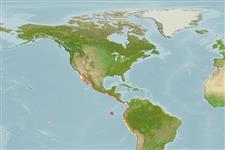Elasmobranchii (sharks and rays) >
Carcharhiniformes (Ground sharks) >
Carcharhinidae (Requiem sharks)
Etymology: Nasolamia: Latin, nasus = nose + Greek, lamia = a monster the eats men (Ref. 45335).
Environment / Climate / Range
Ecology
Marine; demersal; depth range 15 - 192 m (Ref. 96339), usually 15 - 24 m (Ref. 9253). Tropical, preferred ?; 31°N - 18°S
Eastern Pacific: Baja California, Mexico and the Gulf of California to Peru.
Length at first maturity / Size / Weight / Age
Maturity: Lm ?, range 90 - ? cm
Max length : 150 cm TL male/unsexed; (Ref. 244)
Found inshore and offshore on the continental shelves. Feeds on small bony fish, including anchovies, and crabs. Viviparous, with 5 young in a litter. Size at birth about 53 cm. Not known to have attacked people. Utilized fresh and frozen for human consumption and processed for fishmeal.
Viviparous, placental (Ref. 50449). Five pups of about 53 cm TL in each litter (Ref. 28023). Distinct pairing with embrace (Ref. 205).
Compagno, L.J.V., 1984. FAO Species Catalogue. Vol. 4. Sharks of the world. An annotated and illustrated catalogue of shark species known to date. Part 2 - Carcharhiniformes. FAO Fish. Synop. 125(4/2):251-655. Rome: FAO. (Ref. 244)
IUCN Red List Status (Ref. 115185)
CITES (Ref. 94142)
Not Evaluated
Threat to humans
Harmless
Human uses
Fisheries: minor commercial
More information
ReferencesAquacultureAquaculture profileStrainsGeneticsAllele frequenciesHeritabilityDiseasesProcessingMass conversion
Tools
Special reports
Download XML
Internet sources
